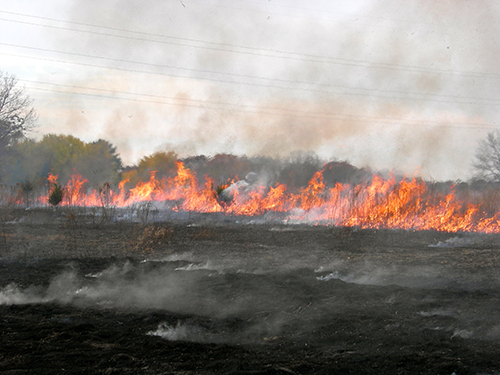
A local prescribed burn at Tawny Oaks in November 2012 shows how nature can be highly flammable. (PHOTO BY MIKE MILLER)

MIKE MILLER
Many will point their fingers, citing that more people are living in fire prone areas. Some will say that we are not adequately managing our forests and wildlands to reduce the impact of wildfires. A few will simply resign that this is the “new normal” in a world that has become increasingly ecologically unpredictable. There is a grain of truth in all of these explanations, but we shouldn’t lose sight of some simple realities.
Fire has been around for as long as there has been enough oxygen in the atmosphere to allow for combustion. Around 2.5 billion years ago, cyanobacteria evolved to use sunlight as an energy source to convert atmospheric carbon dioxide into food and produced oxygen as a byproduct. It’s a process we know as photosynthesis. The new oxygen in the atmosphere actually caused a mass extinction known as the Great Oxygenation Event. Plants thrived and carbon was trapped within their tissues. Those plant tissues accumulated and became buried over time and formed coal and oil deposits trapped under the earth. Eventually, a balance was reached, and things became fairly stable for millions of years. That is until fairly recently.
A clever species came into the picture and learned that all of this stored carbon underground can be used as an energy source. Humans began burning fossil fuels in large enough scale to effect the atmosphere sometime around the early 1800s. Since then, the levels of atmospheric carbon dioxide have continually climbed. But the earth is really a closed system –– a bubble in the vacuum of space. One change brings about another. In the case of our atmosphere, an increase in atmospheric carbon dioxide does not go unnoticed. How are plants today reacting to this increase of carbon dioxide?
Recent studies have shown that plant growth has intensified as a result of increased carbon dioxide levels. These effects are most drastic in normally arid regions that experience an increased frequency of rain events. It is a process known as the CO2 Fertilization Effect. It is no accident that normally arid regions like California, Portugal and Greece have all recently experienced such intense wildfires. This follows spells of heavy rain in which plants are given the green light to grow and take advantage of all of that newly available atmospheric CO2.
It all points back to that clever species that dug up black rocks from the ground and learned that they burn. Clever? Very! Wise? Not so much. We are acting like Nero –– fiddling while Rome burns. Climate change is real, and it’s time to change our ways before we all become piles of ash to be blown to the sea in the Santa Ana winds.

Recent Comments